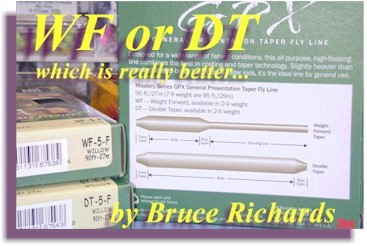

Few fly line subjects have been discussed more than which is the better taper, double taper (DT) or weight forward (WF). The answer is, neither is inherently better, but one may be better than the other for you.
A lot of generalizations are made about these two tapers based on outdated or incorrect information. Weíve all heard that DT lines are more delicate, give better control, roll cast better, etc. In some cases some of these things are true, but not always.
Delicacy of delivery is determined by the mass of the front part of a fly line. This is determined by line diameter (which relates directly to mass), and taper length. A line with a small diameter tip and a long taper has much less mass up front than a line with a large tip and short taper. Donít be mislead by taper length alone, a line with a long front taper but a large tip diameter will not deliver delicately. A DT and a WF line with the same taper and tip diameter will deliver the same.
For many years most DT and WF lines were made with the same tip diameter and front taper length so there was no difference in how they delivered, although many claimed there was. Today, some of the DT lines are actually designed to be used specifically for spring creek type fishing and do have longer tapers and/or smaller tips.
Anytime a line (or any product for that matter) is designed to do one thing very well it usually has a shortcoming somewhere else. Lines that are designed to be very delicate have little mass in the front to carry larger or heavier flies, and donít handle windy conditions well. It takes a better caster to throw the kind of loops it takes to make these lines perform their best. And no, DT lines arenít more ďaccurateĒ at normal fishing distances, that is entirely in the realm of the skill of the caster. Good consistent loops and practice are where accuracy come from.
It is very true that DT lines are easier to control and roll cast at longer distances than WF lines. At shorter distances there is no difference. The key to line control and roll casting is that large diameter line belly must be in the rod tip. If small diameter running line is in the tip it is nearly impossible to transmit enough energy through it to the belly to make the line do what you want. What many people donít consider is that WF lines control and roll cast as well as DT lines at the distances most people fish.
Most WF lines have heads that are 35-40 ft. long. Add a 9 ft. leader and the distance to the fly from the end of the head is 44-49 ft. To that, add the length of the rod since roll cast normally end with the rod parallel to the water and pointed at the target. That is the distance at which DT and WF lines control and roll cast the same. There arenít many typically trout fishing situations that require roll casts longer than that, and not many casters who can roll cast that far. What this all means is that DT and WF lines work pretty much the same at the distances we fish most of the time.
Certainly if someone fishes a big river that requires a lot of long distance roll casting and mending he or she should consider a DT line or a WF with a long head. Rods longer than 9 ft. are almost a necessity also, roll cast distance and mending performance is directly dependent on rod length.
Everybody knows that WF lines are better for distance than DT lines, but is that really true? Well, yes, but the difference isnít as big as you might think. Certainly WF lines shoot better because of their small, light running lines. But remember, this benefit starts at 44-49 ft. when the running line is in the rod. If you will be making a lot of long casts it is certainly a little easier to do with a WF line, but donít think that DT lines wonít shoot, they will, just not as far. With the advent of new slick coatings like AST DTs shoot better than ever.
For most people it probably doesnít make a lot of difference which taper they use. Most of us fish at distances less then 44-49 ft. which is where WFís start to shoot better, but lose line control. Most of us donít have the need, or the ability, to roll cast longer than 45 ft..
So, how do you decide which is right for you? If you do mostly small fly fishing at short to medium range there is no reason not to get a DT line. There is always the budget issue, DT lines are essentially 2 in 1 so are less expensive over time. If you are consistently throwing long casts you will be able to make them with fewer false casts with a WF line, but lose the ability to do long roll casts and mends, if you ever need them, and are able. For most of us it doesnít make much difference which taper we use most of the time, make your decision based on how much short distance fishing, or long range fishing you do.